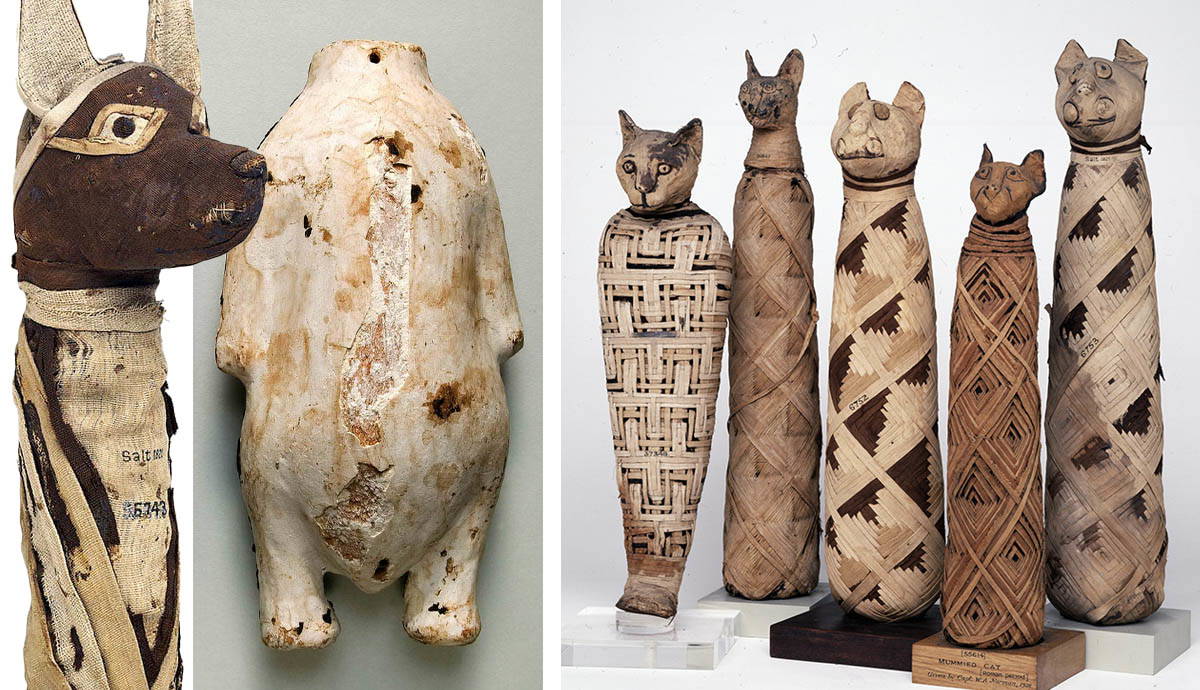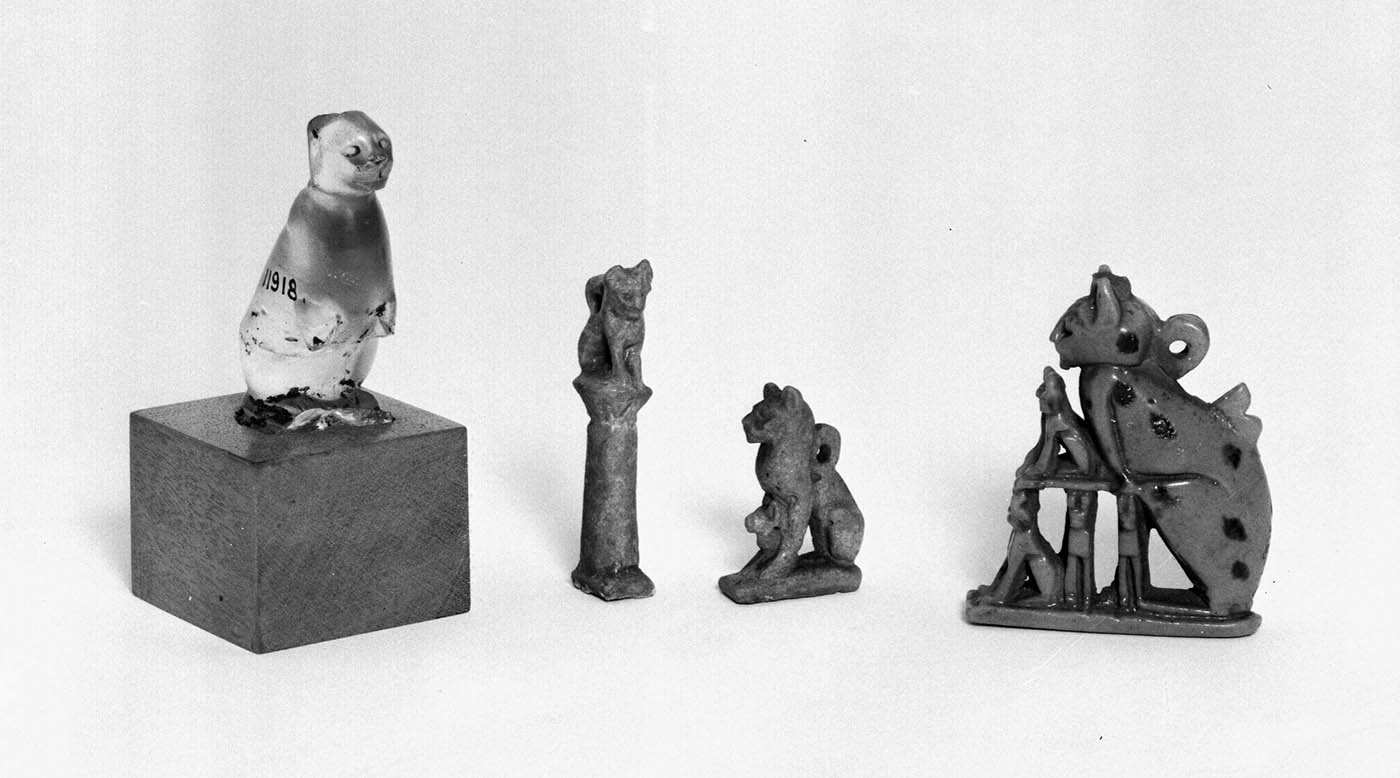
Ancient Egypt wasn’t unique when it came to pets. Civilizations all over the world have appreciated animal companions. However, the way they venerated these pets after death is fascinating. Mummified animals are found in droves in special pet cemeteries and ritual sites, and some are even buried with their owners. The diversity among mummified animals had religious significance, especially when it came to sacred animals — the living embodiments of the Gods.
Mummified Animals in Ancient Egypt

In ancient Egypt, animals were mummified extremely frequently. There are certainly more mummified animals than humans represented in archaeological findings. But why is this? Why did the Egyptians go through the costly (and time-consuming) process of creating mummified animals?
We know that some Egyptians couldn’t afford the mummification process. Usually, only Pharaohs, nobles, and other wealthy citizens were mummified. In this context, the copious amount of mummified animals found at sites across Egypt may seem strange. However, animal mummies served many purposes. There seem to have been five main categories of animal mummies: pets, sacred, votive, food, and “other”. Pets are one of the smallest categories, but this is because sacred mummified animals and votive offerings are so numerous.
Ancient Egyptian Pets

Ancient Egyptians revered their pets in a way that resonates with us today. Beginning early in Egyptian history (the Old Kingdom, c. 2663 BC), pets were depicted in their owners’ tombs. In ancient Egypt, pets were also sometimes mummified and buried with their owners, such as in the case of Prince Thutmose and his cat, one of the first pet cat mummies to be discovered.
If a pet died before its owner, it was mummified and placed within the tomb to await its owner in the afterlife. However, if the owner died first, more drastic measures might be taken. If the owner and their family had willed it, the pet would be able to live out its life. After its death, it could be placed close to the tomb, within the entryway, or even in a small area outside to join its owner.

In some cases, pets were killed so that they could be mummified and entombed with their owner. It can be a bit difficult to spot these cases, except when the animal mummies are examined closely for injuries. Cats weren’t the only pets that ancient Egyptians kept — although that is the popular consensus — many other domestic species were kept as pets. Dogs were another favorite pet, followed by ibises, hawks, falcons, monkeys, snakes — and many more.
Pets as Status Symbols

For some, pets were status symbols. Some wealthy ancient Egyptians were known to keep ‘zoos’ of exotic animal pets, though they were rarely as revered as the beloved family cat or dog. Exotic animals would have been expensive to maintain and difficult to keep, and they often weren’t mummified at the end of their life.
Some would be offered as a sacrifice when the owner died, leading to mass graves of exotic animals with skeletonized remains like the one in Hierakonpolis. The tragedy of these animals is that they were not companions. They weren’t depicted in tombs like cats, dogs, and ibises. They were only status symbols and were seemingly discarded when they became unruly.
Feline Mummies

Common perceptions of ancient Egypt place cats firmly in the role of the divine. We say that cats were sacred in ancient Egypt, but they were just one of several animals held in high esteem. Still, cats seem to have been the most versatile of these animals. They were pets, beloved of the families who kept them. They were also offerings, sacred animals, and a favorite of many pharaohs. It appears that the Egyptians were the first to breed cats, even if they were not the first to domesticate them.
Herodotus famously wrote about the attitude of ancient Egyptians towards cats on one of his visits. He stated that if a house caught fire, the Egyptians would rescue the cats first. Only then would they worry about putting out the flames!

Cats were beloved domestic pets, but they were also useful. They were often used in a hunting capacity, to ward off snakes and rodents, and to take down waterfowl. The large selection of feline mummies excavated at ritual sites and in royal tombs has a lot to tell us. Firstly, pets were very rarely buried with their owners. Many instances of this are present in royal tombs, but those provide the only real examples we have. Perhaps the most famous cat burial is that of Ta-Miu, the pet of 18th Dynasty Crown Prince Thutmose. She is one of the first named cats in human history.
Canine Mummies

Canine mummies are less numerous than feline ones, and most canine mummies that have been discovered were animal offerings. However, many Egyptian households kept hunting dogs. They were present in a working capacity, but they were still pets rather than livestock. Most canine mummies were not entombed as beloved pets. Most were votive offerings to gods that were associated with canines, including Anubis, Wepwawet, and Khentimentiu. These deities are often also associated with death, the afterlife, and associated rituals.

It’s important to note that dog mummies aren’t particularly well-preserved. There are few surviving instances of mummified dogs that haven’t decayed or unraveled. But man’s best friend was still an important part of ancient Egyptian culture. Greyhounds were the most common breed available in the Old Kingdom, while expansion and conquest in later years allowed new breeds to come to Egypt. By the time we reach the animal cults and mass burials of later years, there are a variety of breeds and traits represented among our few intact mummies.
The Sacred Animals of Ancient Egypt

One of the largest categories of mummified animals are the sacred animals. As we know, Egyptians worshipped many deities that aligned themselves with animals. Ibises, for example, were the animal associated with Thoth, the god of learning. In life, these sacred animals were the embodiments of the god himself. They were worshipped as a god, treated as divine, and mummified after their death. The “spirit” of the god would pass to another animal in the same species, and the cycle would continue.
Sacred animals were not kept as pets but were held in esteem as something so much more. Entire temples were dedicated to the upkeep and worship of these animals. They would often be consulted in rituals to deal with dreams and visions.

After death, the animal would be mummified with as much respect as a pharaoh. They were painstakingly mummified, and they were laid to rest in elaborate sarcophagi marked with gold. Offerings were made to these sacred animals (in life and death) in the form of votive offerings.
Abydos, especially, was a center for these animal cults. While this practice was widespread, it seems to have grown in popularity at centers such as Abydos later in ancient Egyptian history. Here, we find a wealth of different animals, including dogs, cats, falcons, bulls, and Ibises. Sometimes, these were votive offerings to a sacred animal. Some were sacred animals themselves.
Votive Offerings

Animal mummies were sometimes used as votive offerings for sacred animals. There were various types of votive offerings, including statues or figurines representing the gods. However, the best and fastest way to get your prayers heard by a deity was to offer an animal sacrifice. For example, some cat mummies were not pets. These cats were sacrificed and mummified as an offering for Bastet, to procure a favor. For Bastet, one would offer a votive mummified cat in hopes of having a child or maintaining good health.

These offerings exist everywhere animal cults are centered. It is sometimes difficult to tell the difference between a votive offering and a sacred animal. Still, the mummification process was faster, less expensive, and more readily available. Often, votive offerings such as mummified animals were sold at temples, allowing visitors to purchase the animal revered by the god in hopes of gaining favor. Most of the animal mummies that have been recovered from excavations are votive offerings.
Mummified Animals as Food for the Pharaohs

Animals that were mummified for food seem unique, but they were widespread within ancient Egypt. In this case, animals were usually not mummified whole. Instead, embalmers would “prepare” the animal as though getting it ready for a feast. Then, they would put it through the mummification process. The idea was that the deceased person — usually a Pharaoh or member of the noble class — would have sustenance in the afterlife. These food offerings were preserved and then placed in containers that were shaped after the food. It seems like a lot of trouble to go through, but these mummies were an integral part of the afterlife for the pharaoh they were offered to.










